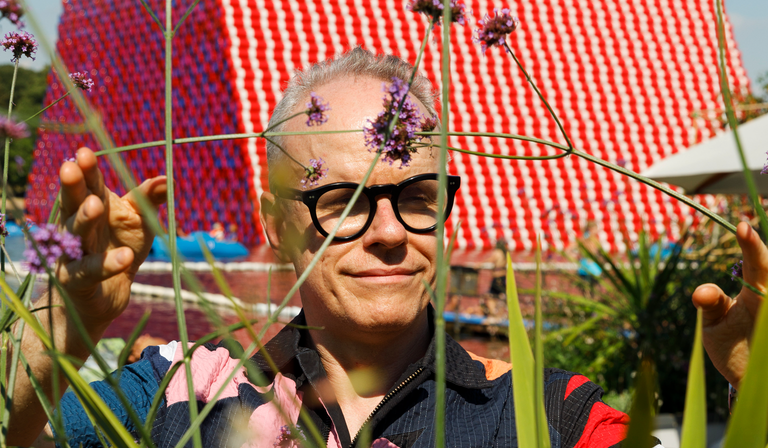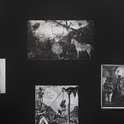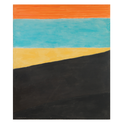In 1989, Magiciens de la Terre, an art exhibition in a former abattoir built under Emperor Napoleon III in northeast Paris, brought together the work of 100 living artists, half of them from the west and half from the rest of the world. These artists would meet for the first time on equal terms, declared the curator, Jean-Hubert Martin, thus revealing a universal spirit of creativity. At least, that was the theory.
Martin was born in the closing months of the Second World War, growing up at a time when, in the west at least, it was a given that great art meant western art. But the west, it turned out, was not ready for a change of approach, and the show was a flop. Kasper König, founding director of Skulptur Projekte Münster and one of the great curators of his generation, brushed it aside as “Unesco art”—pro-forma internationalism driven by insipid politics.
Nearly four decades on, Magiciens de la Terre has come to be seen as one of the most important art shows of the postwar period. It was the first exhibition to point the way towards the globalisation of art, and is as significant in its way as two other key events of 1989: the fall of the Berlin wall and the invention of the internet. As Frances Morris, former director of Tate Modern, wryly remarks: “It was the most famous exhibition that nobody saw.”
Though not an artist himself, Hans Ulrich Obrist could be said to be Magiciens de la Terre’s most devoted child. For nearly 20 years, he has been artistic director of the Serpentine Gallery, the guiding hand behind its annual architectural pavilions as well as its groundbreaking shows, which have helped to introduce artists such as Faith Ringgold and Hilma af Klint to the mainstream. If anyone can see where the world is going, it should be this energetic and focused curator, exhibition maker and Instagrammer.
A devotee of morning rituals, Obrist begins each day by reading the French-Martinican poet and philosopher Édouard Glissant for 20 minutes, before going out for a jog and then writing in a notebook. He used to save money when he was younger (he’s now 57) by taking night trains around Europe to avoid having to pay for hotels. When Obrist worked for the Musée d’Art Moderne de la Ville de Paris in the mid-1990s, his job title was “head of migratory curation”—and he liked to compare himself to the itinerant monks of the medieval period who carried their knowledge with them wherever they went. Today, you’re more likely to spot him in an airline departure lounge or hopping out of a taxi, telephone clapped to his ear.
Obrist has always been a man on the move. An only child, he was born in an area of northeast Switzerland near borders with both Germany and Austria. He was an obsessive boy devoted to books and determined, whenever the family went on holiday near the border with Italy, to persuade his parents to take him at least once over to Lake Como. Anything to get away. “With hindsight,” he writes, “I now see that all those years up to the age of sixteen were a preparation for leaving: an ongoing exercise in readying myself to leave once the moment was right.”
His exhibition-making started in a makeshift way: he’d buy postcards whenever he visited a museum (which was often) and stick them up with plasticine afterwards in his room, organising his shows by period or by groupings of artists. Always fascinated by how art could be seen outside museums, he began visiting artists in their studios to see production at the coalface.
Trapped unexpectedly in the Italian Alps, Obrist bought the village’s entire supply of postcards and sent them to people he’d always dreamed of meeting
The massive expansion of the art world in the past quarter-century means that artists are now surrounded by gallerists, publicists and other gatekeepers. Obrist’s memoir is touching in the way he describes how he used to contact artists to suggest a visit. After a Claude Sandoz show in St Gallen, he asked the receptionist on the way out if she’d pass on his phone number. The next day, Sandoz rang to say he’d be delighted to welcome Obrist to his house in Lucerne. Sometimes he found artists by knocking on their door. Others he looked up in the telephone book. He called Gerhard Richter from his school’s payphone. Trapped unexpectedly by an avalanche in the Italian Alps, he bought out the village’s entire supply of postcards and sent them out to people he’d always dreamed of meeting. He gave them his parents’ address, and a few weeks later the replies started to come in.
On the advice of Christian Boltanski, a French artist who believed literature or art can emerge where you least expect it, Obrist planned his first exhibition in his kitchen—not impractical, since he can’t cook and the space was going to waste. Boltanski projected a slide of a candle where the rubbish bin usually was, Richard Wentworth reproduced the sink and another artist sent drawings of a rose and good coffee. Word got out, and Obrist created a catalogue of the show and then put the book on display, a pattern he would follow for the rest of his life.
As Obrist became more famous, so did his employers. Marie-Claude Beaud gave him free rein at the Cartier Foundation, as did Suzanne Pagé at the Musée d’Art Moderne de la Ville de Paris. He organised a Richter show with the artist at Nietzsche’s house in Switzerland.
The exhibitions with which Obrist was involved fill the bulk of his memoir, though less for an analysis of how contemporary art has developed than for the multi-volume lists of people he came across in his quests. Sentences beginning “I met”, “I called” or “I phoned” inevitably end with a list of names. One sentence runs, “I was obsessed by the figure of Robert Walser—I had discovered him via Kafka”, but offers little explanation why or how.
Obrist had read Giorgio Vasari’s Lives of the Most Excellent Painters, Sculptors and Architects when he was young and liked it for its mix of “sharp insights, anecdotes and gossip”. He wanted to do for the 21st century what Vasari had done in the 1500s. As the art world expanded and Obrist became better known, the night trains of his early days gave way to long-distance flights, and he was more often found writing in a departure lounge than at his desk at home. By the time Covid-19 appeared, he was tired.
He writes of the unexpected joys of that time; how life grew slower and sweeter as a result of lockdown in the spring of 2020. Yet Obrist still spins like a top. Today he is best known for his staged interviews with artists. He’s done more than 1,000, some in the wee hours of the morning, clips from which make up a huge part of his obsessive Instagramming—in recent days, Michelangelo Pistoletto, Alaska Alaska and architect Peter Cook have all made appearances on his feed. Similarly, the closing chapters of his book flick from world literature to art and ecology—and then artificial intelligence.
He quotes Paul Klee, who said that “art can make the invisible visible”. Perhaps. But he might have been advised to listen more carefully to the Italian conceptual artist Alighiero Boetti, whom he visited in Rome. After taking Obrist to see his astrologer, Boetti pronounced the curator to be “incredibly slow” and “truly Swiss”. This may not be an accurate summary of his character, but it is certainly a true description of his book.












